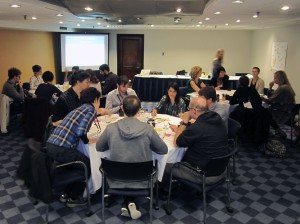Posted by PhD student Daniel Perry
In late October I attended the first annual conference on Computer-Human Interaction in Play (CHI Play 2014) in Toronto. The conference brought together some 150 researchers, academics, and game designers across numerous areas of serious game research and HCI. Sessions at the conference covered a variety of topic areas, including collaboration and communication in serious games, games for health, gamification and education, and game analytics. Research I conducted on co-design with high school youth for the bioinformatics educational game MAX5 was one of several accepted abstracts in a workshop titled Participatory Design for Serious Game Design.
The Participatory Design for Serious Game Design workshop marked one of the highlights of the conference for me, as it brought together participants from all over the world (Malta, Belgium, Germany, Taiwan, Canada, and the U.S to name just a few) to explore the philosophical and methodological challenges of integrating participatory design and serious games. Participatory design (PD) has its roots in Scandinavia some forty years ago as way to empower workers and involve them more directly in the software design process. PD techniques have been adapted and used in a variety of fields and contexts with communities ranging from toddlers to the elderly. While PD often works hand-in-hand with user-centered design approaches, PD’s focus on directly integrating participant design concepts takes a more democratic stance on the design process. In the workshop, we worked in small groups mapping the field of participatory design as we saw it in our own research on games. Topics that emerged included: the use of PD to design games, as well as the use of games as a methodological way to design other types of software systems; the challenge of conveying domain knowledge to participants for learning games (in my own research, this involved getting high school youth up-to-speed with biology and computer science topics in our game); and deciding what design outcomes should be integrated into the final game. While there were no easy answers that came out of the workshop, the importance of transparency in design, as well as providing a tangible sense of participant contribution came up as important issues to address. It was exciting to feel that in many ways we were putting forth a new global agenda for the future of PD in serious games research.
Another highlight of the conference included a keynote by Mike Ambinder, an experimental psychologist at Valve Software (the Seattle-area company behind a host of game favorites including Portal and Left for Dead). In his talk, Mike discussed the current state of the art in gathering game data, and the frequent biases and challenges inherent in the process. He encouraged the audience to imagine the tools and methods that would fill in the data gaps in an ideal research world. I was left with the impression that if a game powerhouse like Valve was facing a daunting data landscape, there is much to gain from further discussions between industry veterans and the academic researcher community. I’m looking forward to attending CHI Play next year.



